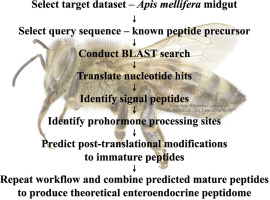当前位置:
X-MOL 学术
›
Insect Biochem. Mol. Biol.
›
论文详情
Our official English website, www.x-mol.net, welcomes your
feedback! (Note: you will need to create a separate account there.)
Assessment of midgut enteroendocrine peptide complement in the honey bee, Apis mellifera.
Insect Biochemistry and Molecular Biology ( IF 3.2 ) Pub Date : 2019-10-31 , DOI: 10.1016/j.ibmb.2019.103257 Andrew E Christie 1
Insect Biochemistry and Molecular Biology ( IF 3.2 ) Pub Date : 2019-10-31 , DOI: 10.1016/j.ibmb.2019.103257 Andrew E Christie 1
Affiliation

|
Peptides modulate physiological/behavioral control systems in all animals. In arthropods, midgut epithelial endocrine cells are one of the largest sources of these signaling agents. At present, little is known about the identity of the peptides that form arthropod midgut enteroendocrine peptidomes. While many techniques can be used for peptide structural identification, in silico transcriptome mining is one that has been used extensively for arthropod neuropeptidome prediction; this strategy has yet to be used for large-scale arthropod enteroendocrine peptide discovery. Here, a tissue-specific transcriptome was used to assess putative enteroendocrine peptide complement in the honey bee, Apis mellifera, midgut. Searches for transcripts encoding members of 42 peptide families were conducted, with evidence of expression for 15 groups found in the assembly: adipokinetic hormone, allatostatin A, allatostatin C, bursicon, CCHamide, CNMamide, diuretic hormone 31, diuretic hormone 44, insulin-like peptide, myosuppressin, neuropeptide F, pigment dispersing hormone, pyrokinin, short neuropeptide F, and tachykinin-related peptide. The proteins deduced from the midgut transcripts are identical in sequence, or nearly so, to those of Apis pre/preprohormones deposited previously into NCBI, providing increased confidence in the accuracy of the reported data. Seventy-five peptides were predicted from the deduced precursor proteins, 26 being members of known peptide families. Comparisons to previously published mass spectrometric data support the existence of many of the predicted Apis peptides. This study is the first prediction of an arthropod midgut peptidome using transcriptomics, and provides a powerful new resource for investigating enteroendocrine peptide signaling within/from the Apis midgut, a species of significant ecological/economic importance.
中文翻译:

蜜蜂Apis mellifera中肠肠内分泌肽补体的评估。
肽调节所有动物的生理/行为控制系统。在节肢动物中,中肠上皮内分泌细胞是这些信号传导剂的最大来源之一。目前,关于形成节肢动物中肠肠内分泌肽组的肽的身份知之甚少。尽管许多技术可用于肽结构鉴定,但计算机转录组挖掘技术已被广泛用于节肢动物神经肽组的预测。该策略尚未用于大规模节肢动物肠内分泌肽的发现。在这里,组织特异性转录组被用来评估蜜蜂Apis mellifera,中肠中的推定肠内分泌肽补体。搜索编码42个肽家族成员的转录本,大会中有15组表达的证据:脂肪代谢激素,阿托他汀A,阿他他汀C,bursicon,CCHamide,CNMamide,利尿激素31,利尿激素44,胰岛素样肽,肌抑制素,神经肽F,色素分散激素,丙酮酸,短神经肽F和速激肽相关肽。从中肠转录本推导的蛋白质与先前沉积在NCBI中的Apis pre / preprohormones的蛋白质在序列上几乎相同,或几乎相同,从而提高了报告数据准确性的可信度。从推导的前体蛋白中预测了75种肽,其中26种是已知肽家族的成员。与以前发布的质谱数据进行比较,支持许多预测的Apis肽的存在。
更新日期:2019-10-31
中文翻译:

蜜蜂Apis mellifera中肠肠内分泌肽补体的评估。
肽调节所有动物的生理/行为控制系统。在节肢动物中,中肠上皮内分泌细胞是这些信号传导剂的最大来源之一。目前,关于形成节肢动物中肠肠内分泌肽组的肽的身份知之甚少。尽管许多技术可用于肽结构鉴定,但计算机转录组挖掘技术已被广泛用于节肢动物神经肽组的预测。该策略尚未用于大规模节肢动物肠内分泌肽的发现。在这里,组织特异性转录组被用来评估蜜蜂Apis mellifera,中肠中的推定肠内分泌肽补体。搜索编码42个肽家族成员的转录本,大会中有15组表达的证据:脂肪代谢激素,阿托他汀A,阿他他汀C,bursicon,CCHamide,CNMamide,利尿激素31,利尿激素44,胰岛素样肽,肌抑制素,神经肽F,色素分散激素,丙酮酸,短神经肽F和速激肽相关肽。从中肠转录本推导的蛋白质与先前沉积在NCBI中的Apis pre / preprohormones的蛋白质在序列上几乎相同,或几乎相同,从而提高了报告数据准确性的可信度。从推导的前体蛋白中预测了75种肽,其中26种是已知肽家族的成员。与以前发布的质谱数据进行比较,支持许多预测的Apis肽的存在。











































 京公网安备 11010802027423号
京公网安备 11010802027423号